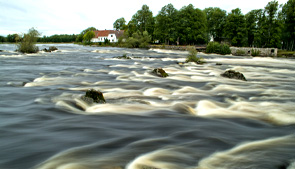Due to climate change, the coastal areas of the Baltic Sea are especially susceptible to flooding and coastal erosion risks. Climate change will also have a significant impact on river discharge and water availability.
Climate Changes: Impacts, Costs and Adaptation in the Baltic sea region
Abbreviation
BaltCICA
Project Identification Nr.
#11
Field
Nature protection, Climate Changes
Implementation Area
Latvia and all countries of Baltic sea region
Demonstration Areas
In the NCA Northern Vidzeme Biosphere Reservation, the shore of the Gulf of Riga and the drainage basin area of the River Salaca have been selected as demonstration sites
Project Finance Source
ERDF
Project Joint Funding
80 097 LVL
Project Leader Partner
Geological Survey of Finland (GTK)
Land Use and Environment
Betonimiehenkuja 4, P.O. Box 96, FIN - 02151 Espoo, FINLAND
Telephone: +358 20 550 2628, Fax: +358 20 550 12
Email: johannes.klein@gtk.fi , www.gtk.fi
Project Partners
In Project are 24 partner countries of the BSR:
- Latvia:
- University of Latvia, www.lu.lv
- Finland:
- Geological Survey of Finland, www.gtk.fi
- Helsinki University of Technology, Center for Urban and Regional Studies, www.tkk.fi
- Hanko Water and Waster waterworks, www.hanko.fi
- Union of Baltic Cities Commission on Environment, www.ubc-action21.net
- Helsinki Metropolitan Area Council, www.ytv.fi
- City of Helsinki, www.hel.fi
- City of Tampere, www.tampere.fi
- Estonia:
- Geological Survey of Estonia, www.egk.ee
- Lithuania:
- Municipality of Klaipeda, www.klaipeda.lt
- Municipality of Klaipeda District, www.klaaipedos-r.lt
- Environmental Centre for Administration and Technology, www.ecat.lt
- University of Vilnius, www.vu.lt
- Lithuanian Geological Survey under the Ministry of Environment, www.lgt.lt
- Denmark:
- Municipality of Kalundborg, www.kalundborg.dk
- Danish Board of Technology, www.tekno.dk
- Geological Survey of Denmark and Greenland, www.geus.dk
- Sweden:
- Nordic Centre for Spatial Development, www.nordregio.se
- Norway:
- Norwegian Institute of Urban and Regional Research, www.nibr.no
- Germany:
- Leibniz Institute for Baltic Sea Research, Warnemunde, www.io-warnemuende.de
- Hafen City University Hamburg, Institute for Urban-, Regional- and Env. Planning, www.hcu-hamburg.de
- EUCC-The Coastal Union Germany, www.eucc-d.de
- Institute for Climate Impact Research, Potsdam, www.pik-potsdam.de
Project Duration
3 years (01.02.2009.-31.01.2012.)
Contact Persons
Andris Urtāns, Project manager and responsible person, tel +371 26535641, Andris.urtans@daba.gov.lv,
www.daba.gov.lv
Liene Jermacāne, project coordinator, tel.+371 28675722, liene.jermacane@daba.gov.lv
Project Web Page
Project Short Description
The priority is the sustainable management of the Baltic Sea as a common resource. The main activities are geared towards limiting the environmental pollution of the Baltic Sea, which directly impacts the marine environment. A special focus is on the coastal areas of the BSR within the context of climate change, and on coastal security.
Due to climate change, the coastal areas of the Baltic Sea are especially susceptible to flooding and coastal erosion risks. Climate change will also have a significant impact on river discharge and water availability. The territory of the Northern Vidzeme Biosphere Reserve (NVBR) comprises more than 10 % of the Baltic Sea coast area of Latvia and the catchment of the River Salaca. In cooperation with experts from the University of Latvia and local governments within the NVBR, a discussion will take place and changes will be made to the spatial planning documents in line with EU legislation in the field of climate change, and the requirements of the EU Floods and Water Structural Directive will be integrated.
Project Goals
Facilitating national policy on the implementation of global climate change reduction initiatives by organising seminars to raise the awareness of the local community and for coastal municipalities – on integrating climate change adaptation mechanisms in spatial planning.
Involving the public in active and conscious steps to reduce climate change at the local scale and in public monitoring of water quality and coastal erosion processes.
Arranging an interactive exhibition on climate change and the possibilities of reducing it, thus creating a regional learning and training centre for global climate change education.
Project Main Tasks
Actively involve the local community in the public monitoring of water quality and coastal erosion processes and the reduction of the effects of climate change; organise seminars to raise the awareness of the local community regarding the national policy and its implementation with respect to the reduction of climate change; to create an interactive exhibition on climate change and the possibilities to reduce it. By implementing the set of measures provided for in the project, there is a plan to transform the NVBR information and education centre into a regional support centre of the Ministry of Environment for educating the wider public on the solutions arrived at as a result of the climate change reduction policy and pilot projects.
Planed Outputs
Twelve seminars for local governments have been conducted on the integration of climate change adaptation mechanisms into spatial plans (mainly as restrictions on shore construction developments in conjunction with the map of future areas subject to flooding and storm exposure); a climate change adaptation strategy has been developed for the Salacgrīva Municipality, thus facilitating the implementation of national policy on the reduction of global climate change.
Forty-eight training seminars have been conducted for the students of the general education schools in the coastal area of the NVBR, local librarians and members of community support groups on public monitoring and the reduction of climate change in the specific municipalities.
An interactive exhibition has been created on the adaptation to climate change.




